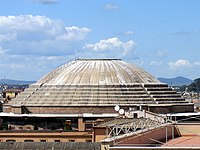
Photo from wikipedia
The effects of nano-SiO2 and superabsorbent polymer on the hydration process of early-age cement paste are investigated through the physically bound water evolution test by means of the low-field nuclear… Click to show full abstract
The effects of nano-SiO2 and superabsorbent polymer on the hydration process of early-age cement paste are investigated through the physically bound water evolution test by means of the low-field nuclear magnetic resonance technology. The test results show that the hydration process can be characterized by four-stage patterns based on the zero points of the second-order differential hydration curve, i.e., the initial, accelerated, decelerated, and steady periods. The beginning time of each stage is postponed and the hydration duration is prolonged with an increasing water to cement ratio. The beginning time of each stage and the hydration duration are shortened with an increasing content of nano-SiO2. And the beginning time of each stage and the hydration duration are prolonged with an increasing content of superabsorbent polymer. Based on the test data and the Avrami–Erofeev model, a modified hydration model taking the influence of nano-SiO2 and SAP into account is proposed, and the predicted results are consistent with the test results.
Journal Title: Advances in Materials Science and Engineering
Year Published: 2020
Link to full text (if available)
Share on Social Media: Sign Up to like & get
recommendations!